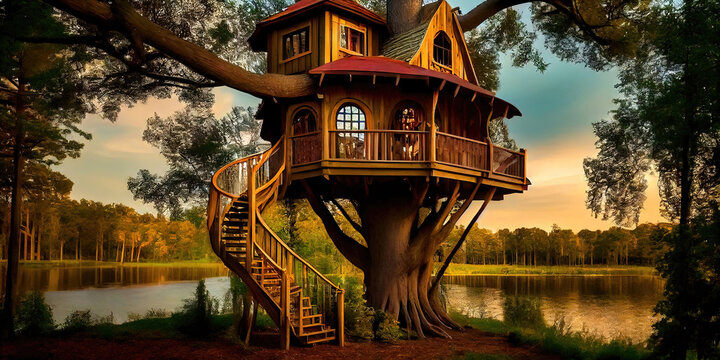
The Charm and Innovation of Tree Houses: A Blend of Nature and
Tree houses have fascinated people for centuries, combining a childlike sense of adventure with sophisticated architectural design. They offer a unique escape from the everyday, blending seamlessly with the natural environment while providing a distinctive living experience. From rustic retreats to modern marvels, tree houses have evolved into versatile structures that appeal to both the young and the young at heart.
Historical Context
Tree houses are not a modern invention. Historical records and architectural studies reveal that various cultures have used tree-based structures throughout history. Ancient civilizations in Southeast Asia, for example, constructed tree houses as defensive structures and homes. In more recent history, the idea of living in a tree house became popular in the Western world during the 19th and 20th centuries, thanks in part to the works of writers and designers who romanticized the concept.
Design and Architecture
Modern tree houses have transcended their simplistic origins to become architectural statements. Today, they are designed with a focus on sustainability, innovation, and aesthetics. Key elements of contemporary tree house design include:
- Structural Integrity: Advanced engineering techniques ensure that tree houses are stable and safe. Modern tree houses are often built using cantilevered designs or support systems that minimize damage to the trees and maximize stability.
- Materials: The choice of materials is crucial in tree house construction. Sustainable materials like reclaimed wood, bamboo, and eco-friendly composites are commonly used. The use of these materials not only blends the structure with its natural surroundings but also promotes environmental stewardship.
- Integration with Nature: Tree houses are designed to integrate seamlessly with their environment. Large windows, open floor plans, and decks allow occupants to enjoy unobstructed views of the surrounding landscape. The use of natural materials and colors helps the tree house blend into the forest or garden setting.
- Functionality: While some tree houses serve as simple retreats, others are equipped with modern amenities. Luxurious tree houses may include features such as running water, electricity, and even high-speed internet. They can function as guest houses, offices, or vacation rentals.
Cultural Impact
Tree houses have captured the imagination of people worldwide and have become symbols of creativity and a deeper connection with nature. They are featured in literature, film, and art, often representing an idealistic escape from the hustle and bustle of everyday life. The tree house has also become a popular theme in experiential travel, with many eco-resorts and luxury accommodations offering tree house stays as unique experiences.
Environmental Considerations
Building a tree house requires careful consideration of environmental impact. Sustainable practices include:
- Minimizing Damage to Trees: Proper techniques are used to ensure that the tree’s health is not compromised. Tree houses are often designed to be temporary or lightweight to prevent long-term damage.
- Eco-Friendly Materials: The use of sustainable and recycled materials helps reduce the ecological footprint of tree house construction.
- Waste Management: Incorporating systems for waste management and recycling ensures that the tree house maintains a minimal environmental impact.
Educational and Therapeutic Benefits
Tree houses also offer educational and therapeutic benefits:
- Educational Opportunities: Tree houses provide unique learning environments for children and adults alike. They offer hands-on experiences with nature and can serve as outdoor classrooms for environmental education.
- Therapeutic Effects: The elevated position and natural setting of tree houses can have calming and therapeutic effects. They offer a peaceful retreat from the stress of daily life, fostering relaxation and mental well-being.
Community and Social Aspects
Tree houses can also play a role in fostering community and social interaction:
- Community Spaces: Some tree houses are designed as communal spaces where families and friends gather. They can serve as hubs for social activities, fostering stronger connections and shared experiences.
- Public Projects: Tree house projects in public spaces, such as parks and nature reserves, offer visitors unique experiences and promote community engagement with nature. These projects can also serve as educational tools for environmental awareness.
Conclusion
Tree houses embody a perfect fusion of creativity, adventure, and environmental consciousness. They offer a unique way to experience nature while enjoying the comforts of modern living. Whether as a whimsical retreat or a sophisticated residence, tree houses continue to inspire and captivate those who dream of a life among the branches.